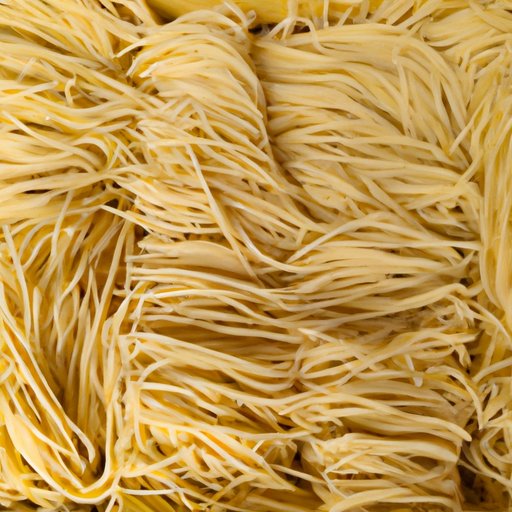
Introduction
Who doesn’t love a plate of comforting, warm egg noodles? Whether you’re making them for a cozy dinner at home or for a gathering with friends, homemade egg noodles add that special touch to any dish. In this article, we will guide you through the process of making perfect egg noodles from scratch. This guide is for anyone who loves to cook – whether you’re a seasoned chef or a novice in the kitchen.
Step-by-Step Guide: How to Make Egg Noodles from Scratch
Here are the ingredients you will need for a batch of about three servings:
- 2 cups of all-purpose flour
- 2 large eggs
- 1/2 tsp salt
- 1/4 cup water
Follow these steps to make the perfect egg noodles:
Step 1: Prepare the Dough
1. In a mixing bowl, whisk together the flour and salt.
2. Make a well in the center of the flour mixture and crack the eggs into it. Beat the eggs with a fork while gradually incorporating the flour from the sides until a dough forms.
3. Add a little bit of water at a time, as needed, to form a smooth and elastic dough. Knead the dough for five minutes to activate the gluten and develop elasticity.
4. Cover the dough with a damp towel and let it rest for at least 30 minutes to allow the gluten strands to relax, making the dough more pliable.
Step 2: Roll Out and Cut the Noodles
1. Divide the dough into four equal parts and roll out each part into a rectangle or circle shape that is approximately 1/8 inch thick.
2. Sprinkle a little flour on top of the rolled-out dough to prevent it from sticking. Fold the dough in half, then in half again to make a rectangle or square shape, then slice the noodles in the desired width.
3. Gently unfold the noodles and dust again with flour.
4. Store the noodles in small batches in a single layer covered in plastic wrap.
Step 3: Cook the Noodles Perfectly
1. Bring a pot of salted water to a boil. For every 16 oz. of pasta, use a minimum of 4 quarts of water and 1 tablespoon of salt.
2. Gently add the noodles to the boiling water and stir immediately to prevent them from sticking together. Cook the noodles for about 2-3 minutes or until they float to the surface.
3. Drain the water and rinse the noodles briefly with cold water to prevent them from overcooking and turning mushy. Toss the noodles with olive oil or melted butter to add flavor and prevent clumping.
Step 4: Helpful Tips and Tricks
1. Always measure your flour and water accurately to ensure the dough consistency.
2. If you don’t have a pasta machine, you can roll out your dough with a rolling pin and cut the noodles with a sharp knife.
3. Don’t be afraid to add additional seasoning into the noodles like garlic, chili flakes, or herbs for added flavor.
Personal Tips and Tricks for Making Egg Noodles
As someone who has been making egg noodles for years at home, I can share some helpful tips and tricks that I’ve picked up along the way:
1. When kneading the dough, use the palm of your hand instead of your fingertips. This will prevent tearing and create smooth dough.
2. If the dough is dry and hard to knead, add a few drops of water at a time until the dough becomes more elastic.
3. Rolling out noodles too thick can make them chewy, while rolling them out too thin may lead to breakages while cooking. Experiment with different thicknesses to find the perfect texture.
4. Always work with small batches of noodles to prevent them from clumping together while cooking.
Ingredient Substitutions for Egg Noodles
If you have a gluten allergy or want to avoid it, you can substitute regular flour with gluten-free flour, such as rice flour, almond flour, or chickpea flour. Keep in mind that the dough may not be as elastic as traditional egg noodles. Additionally, if you’re allergic to eggs, try replacing the eggs with an equal amount of applesauce, mashed bananas, or silken tofu.
Cultural Significance of Egg Noodles
Egg noodles originated in China during the Tang Dynasty, where they were known as “longevity noodles” and were considered a symbol of long life. The popularity of the egg noodle spread throughout Asia and Europe, where they became a staple in many households and restaurant kitchens. In the United States, egg noodles are commonly used in comfort foods like chicken noodle soup, beef stroganoff, and kugel, a traditional Jewish dish.
Recipe Variations for Egg Noodles
Here are some recipe variations that you can try to take egg noodles to the next level:
1. Fettuccine Alfredo – Toss the egg noodles with homemade Alfredo sauce made from garlic, heavy cream, and parmesan cheese. Add shrimp or chicken for protein.
2. Ramen – Boil the egg noodles and serve them in a chicken or pork broth with sliced mushrooms, green onions, and a soft-boiled egg.
3. Stir-Fry – Sauté the egg noodles with mixed vegetables, ginger, garlic, soy sauce, and a dash of chili sauce for a quick and easy dinner.
Conclusion
With these simple tips and tricks, you are now equipped to make perfect egg noodles every time. Whether you stick to the classic recipe or experiment with different variations, egg noodles are an easy and satisfying dish to make at home. The cultural significance and versatility of egg noodles make them a beloved staple across the world.




